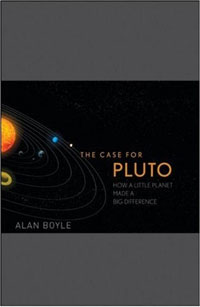Review: The Case for Plutoby Jeff Foust
|
| “Pluto isn’t the ninth of nine,” Boyle writes, “it’s the first of many.” |
Boyle traces the debate about whether Pluto is a planet to a speech by Brian Marsden, then head of the Minor Planets Center, in a 1980 speech at a conference marking the 50th anniversary of Pluto’s discovery, where he suggested that Pluto should be reclassified as a minor planet. That argument raged off and on for a quarter-century before the fateful IAU meeting in 2006, covered in detail in the book. The “Battle of Prague” (as Boyle titles the chapter of the book that deals with the meeting) was less a conflict between friends and foes of Pluto than it was between geophysicists and dynamicists: the former wanted to use a body’s roundness as the primary criterion for planethood, which would include Pluto and several other worlds, while the latter favored the body’s ability to clear out its orbit, which would exclude those worlds. The dynamicists won the day, and the rest is history—at least for now.
In the book’s final chapter, also titled “The Case for Pluto”, Boyle makes his case for how Pluto should be classified. “Pluto isn’t the ninth of nine,” he writes, “it’s the first of many.” That is, it should be considered the first of a class of planets that stands alongside terrestrial and jovian planets. (This class is called “dwarf planets” later in the chapter, although it’s different from the IAU definition, where “planets” and “dwarf planets” are two distinct categories.) There are potentially hundreds of such dwarf planets in the solar system, a change that may be difficult for people used to a solar system of nine (or eight) planets. “Some people may find it difficult to handle a planetary paradigm shift, but shift happens, whether we like it or not.”
One of the biggest lessons from the book is a reminder that science is practiced by people, and thus how a debate like this “shows how politics and personalities can affect the scientific process”. The Case for Pluto is a good summary of the debate on Pluto’s identity, and a reminder that as our knowledge of the solar system and the universe changes, our structure for classifying that knowledge must change as well.
